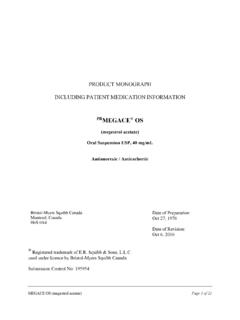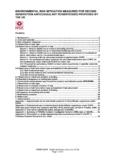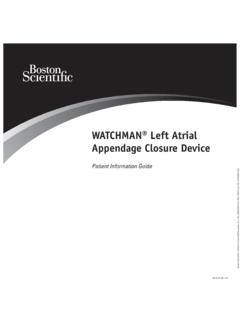Transcription of PRODUCT MONOGRAPH - Bristol-Myers Squibb
1 PrELIQUIS (apixaban) PRODUCT MONOGRAPH Page 1 of 78 PRODUCT MONOGRAPH PrELIQUIS apixaban tablets mg and 5 mg anticoagulant Pfizer Canada Inc. 17,300 Trans-Canada Highway Kirkland, Quebec H9J 2M5 Bristol-Myers Squibb Canada Co. Montreal, Canada H4S 0A4 Date of Preparation: 23 October 2018 Registered trademark of Bristol-Myers Squibb Company used under license by Bristol-Myers Squibb Canada Co. Submission Control No: 198842 PrELIQUIS (apixaban) PRODUCT MONOGRAPH Page 2 of 78 Table of Contents PART I: HEALTH PROFESSIONAL INFORMATION.
2 3 SUMMARY PRODUCT 3 INDICATIONS AND CLINICAL USE .. 3 CONTRAINDICATIONS .. 4 WARNINGS AND PRECAUTIONS .. 4 ADVERSE REACTIONS .. 10 DOSAGE AND ADMINISTRATION .. 25 OVERDOSAGE .. 31 ACTION AND CLINICAL PHARMACOLOGY .. 32 SPECIAL HANDLING INSTRUCTIONS .. 37 DOSAGE FORMS, COMPOSITION AND 38 PART II: SCIENTIFIC INFORMATION .. 39 PHARMACEUTICAL INFORMATION .. 39 CLINICAL TRIALS .. 40 DETAILED PHARMACOLOGY .. 70 TOXICOLOGY .. 71 REFERENCES .. 73 PART III: CONSUMER INFORMATION .. 75 PrELIQUIS (apixaban) PRODUCT MONOGRAPH Page 3 of 78 PrELIQUIS Apixaban tablets PART I: HEALTH PROFESSIONAL INFORMATION SUMMARY PRODUCT INFORMATION Route of Administration Dosage Form / Strength Nonmedicinal Ingredients Oral Tablet, mg and 5 mg Anhydrous lactose, croscarmellose sodium, hypromellose, lactose monohydrate, magnesium stearate, microcrystalline cellulose, sodium lauryl sulphate, titanium dioxide, triacetin, red iron oxide (5 mg tablets) and yellow iron oxide ( mg tablets).
3 INDICATIONS AND CLINICAL USE ELIQUIS (apixaban) is indicated for: the prevention of venous thromboembolic events (VTE) in adult patients who have undergone elective knee or hip replacement surgery. the prevention of stroke and systemic embolism in patients with atrial fibrillation. the treatment of venous thromboembolic events (deep vein thrombosis [DVT], pulmonary embolism [PE]) and prevention of recurrent DVT and PE. Geriatrics ( 65 years of age) Clinical studies in VTE prevention, stroke prevention in patients with atrial fibrillation (SPAF), treatment of DVT and PE, and prevention of recurrent DVT and PE included patients 65 years of age (see WARNINGS AND PRECAUTIONS, Renal Impairment, DOSAGE AND ADMINISTRATION, and CLINICAL TRIALS).
4 Pediatrics (< 18 years of age) The safety and efficacy of ELIQUIS in pediatric patients have not been established; therefore, Health Canada has not authorized an indication for pediatric use. Pharmacokinetic / pharmacodynamic data are available from a single-dose pediatric study (28 days to 18 years) (see ACTION AND CLINICAL PHARMACOLOGY, Special Populations and Conditions). PrELIQUIS (apixaban) PRODUCT MONOGRAPH Page 4 of 78 CONTRAINDICATIONS Clinically significant active bleeding, including gastrointestinal bleeding Lesions or conditions at increased risk of clinically significant bleeding, , recent cerebral infarction (ischemic or hemorrhagic)
5 , active peptic ulcer disease with recent bleeding, patients with spontaneous or acquired impairment of hemostasis Hepatic disease associated with coagulopathy and clinically relevant bleeding risk (see ACTION AND CLINICAL PHARMACOLOGY, Hepatic Impairment) Concomitant systemic treatment with strong inhibitors of both CYP 3A4 and P-glycoprotein (P-gp) such as azole-antimycotics, , ketoconazole, itraconazole, voriconazole, or posaconazole, and HIV protease inhibitors, , ritonavir (see WARNINGS AND PRECAUTIONS, Drug Interactions, and DRUG INTERACTIONS, Inhibitors of both CYP 3A4 and P-gp) Concomitant treatment with any other anticoagulant , including o unfractionated heparin (UFH), except at doses used to maintain a patent central venous or arterial catheter, o low molecular weight heparins (LMWH)
6 , such as enoxaparin and dalteparin, o heparin derivatives, such as fondaparinux, and o oral anticoagulants, such as warfarin, dabigatran, rivaroxaban, except under circumstances of switching therapy to or from apixaban. Hypersensitivity to ELIQUIS (apixaban) or to any ingredients of the formulation. For a complete listing of ingredients see DOSAGE FORMS, COMPOSITION AND PACKAGING. WARNINGS AND PRECAUTIONS PREMATURE DISCONTINUATION OF ANY ORAL anticoagulant , INCLUDING ELIQUIS, INCREASES THE RISK OF THROMBOTIC EVENTS.
7 To reduce this risk, consider coverage with another anticoagulant if ELIQUIS is discontinued for a reason other than pathological bleeding or completion of a course of therapy. The following Warnings and Precautions are listed in alphabetical order. Bleeding The possibility of a hemorrhage should be considered in evaluating the condition of any anticoagulated patient. As with all anticoagulants, ELIQUIS (apixaban) should be used with caution in circumstances associated with an increased risk of bleeding. Bleeding can occur at any sit e during therapy with ELIQUIS.
8 An unexplained fall in hemoglobin, hematocrit or blood pressure should lead to a search for a bleeding site. Patients at high risk of bleeding should not be prescribed ELIQUIS (see CONTRAINDICATIONS). PrELIQUIS (apixaban) PRODUCT MONOGRAPH Page 5 of 78 Should severe bleeding occur, treatment with ELIQUIS must be discontinued and the source of bleeding investigated promptly. Close clinical surveillance ( , looking for signs of bleeding or anemia) is recommended throughout the treatment period. This may include looking for obvious signs of bleeding, hematomas, epistaxis, or hypotension, testing for occult blood in the stool, checking serum hemoglobin for significant decrease, etc.
9 , especially if other factors/conditions that generally increase the risk of hemorrhage are also present. (see Table 1 below). Table 1 Factors Which Increase Hemorrhagic Risk Factors increasing apixaban plasma levels Severe renal impairment (eCrCl < 30 mL/min) Concomitant systemic treatment with strong inhibitors of both CYP 3A4 and P-gp Pharmacodynamic interactions NSAID Platelet aggregation inhibitors, including ASA, clopidogrel, prasugrel, ticagrelor Diseases / procedures with special hemorrhagic risks Congenital or acquired coagulation disorders Thrombocytopenia or functional platelet defects Uncontrolled severe arterial hypertension Active ulcerative gastrointestinal disease Recent gastrointestinal bleeding Recent intracranial hemorrhage Intraspinal or intracerebral vascular abnormalities Recent brain.
10 Spinal or ophthalmological surgery Bronchiectasis or history of pulmonary bleeding Others Age > 75 years Concomitant use of ELIQUIS with drugs affecting hemostasis increases the risk of bleeding. Care should be taken if patients are treated concomitantly with drugs affecting hemostasis such as non-steroidal anti-inflammatory drugs (NSAID), acetylsalicylic acid (ASA). Concomitant use of ASA or dual antiplatelet therapy with either ELIQUIS or warfarin increases the risk of major bleeding in patients with atrial fibrillation.













